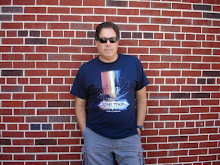Sunday, September 15, 2013
MAD MAX
(April 1979, U.S.)
Were it not for the immense popularity of THE ROAD WARRIOR (1982) and the multiple times I watched it on HBO in 1983, I might not have ever discovered its predecessor, MAD MAX. In fact, at the young age of sixteen, I had no idea that THE ROAD WARRIOR was a sequel at all. While it's opening sequence featured a narrated backstory and black and white images from the first film, I still didn't seem to possess enough film smarts at the time to put the two together. Were it not for the sequel and its opening narration, I might not have ever even surmised that MAD MAX took place in a dystopian future where fuel and gasoline are in major exhausted supply because the film itself doesn't make that one hundred percent clear. Regardless, this vision of the future set just "a few years from now" has created lawlessness where psychotic motorcycle gangs have taken over the highways and prey upon innocent citizens. And so, enter MAD MAX, our hero and protector.
Max Rockatansky (played by a very young and still unknown Mel Gibson) is a Main Force Patrol officer fighting for peace on the roads of a Australia. Max is quiet, rarely speaking to any great extent, and never paying much attention to his steadily increasing violent reputation. He shares his life with his wife, Jessie (played by Joanne Samuel) and their infant son. Though clearly the best officer on the force, he secretly worries that he's becoming as cold and heartless as the criminals he pursues. He reaches a breaking point when a gang of bikers known as the Zed Runners attack his partner, Goose, and burn him alive. Max announces that he's quitting the force and goes on holiday with his wife and son. The bikers, however, in their random rampage, encounter Jessie and her child. She's able to fend them off however the bikers eventually catch back up, and Max is unable to prevent Jessie and his child's murder. Now overwhelmed with grief and rage, he systematically pursues and kills the gang members that are responsible. Max is injured in an ambush set for him by the Toe-Cutter (played by Hugh Keays-Byrne), but still manages to shoot his enemies through sheer violent hatred and willpower and inevitably chases the Toe-Cutter to his death before hunting down and killing the last remaining gang member, Johnny the Boy (played by Tim Burns, whom you may recognize as the desperate jumper in the first LETHAL WEAPON film). Max is last seen driving out into the wasteland, leaving the fading remnants of civilization behind him, and setting up premises for what will become THE ROAD WARRIOR.
At the time of its release, it's easy to see how the violent contents of MAD MAX could ultimately become an ugly special favorite of rapists, sadists and child murderers, perhaps not too unlike A CLOCKWORK ORANGE eight years prior. However, when one considers the many post-apocalyptic visions of the future that have been depicted on screen since 1979 (and even some before), the idea that our human society is likely to become a race of sadistic animals has become such a common norm of fiction, that to look back on the violent characters and implications of MAD MAX and take it with any degree of true seriousness becomes considerably more questionable. In other words, what I think I'm trying to say is that I don't believe it will require global apocalypse to bring out the truly ugly side of human nature. Just look up some of the more unpleasant events that took place after Hurricane Sandy and the gas shortage that followed in October 2012 and perhaps you'll see what I'm talking about!
Favorite line or dialogue:
Max Rockatansky: "I'm scared, Fif. It's that rat circus out there, I'm beginning to enjoy it. Look, any longer out on that road and I'm one of them, a terminal psychotic, except that I've got this bronze badge that says that I'm one of the good guys."
Subscribe to:
Post Comments (Atom)



No comments:
Post a Comment